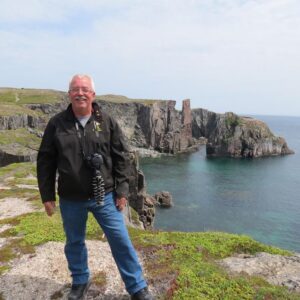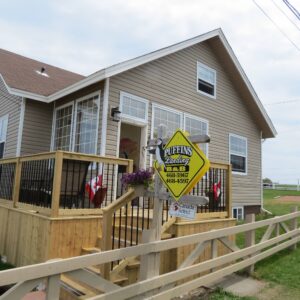Around the World
Puffins Landing: From Thrilling History to Tourist Hotspot
Jul 2023 | By Pat Brennan
The mating season is over out on the stormy North Atlantic and the colourful little puffins are winging their way back to Newfoundland’s rocky shore.
 On craggy cliff sides they’ll build their nest — the responsibility of the males only — to lay their eggs and raise their young.
On craggy cliff sides they’ll build their nest — the responsibility of the males only — to lay their eggs and raise their young.
The puffins aren’t snowbirds. They don’t fly south in the fall. They fly east to winter on the wild North Atlantic.
Keith and Maureen Abbott aren’t snowbirds either. With the puffins returning to Canada, the Abbotts are packing their bags and also heading home to Puffins Landing, the popular B&B they operate overlooking puffin-filled islands in Bonavista, Newfoundland. The Abbotts spend their winters in cold, snowy Peterborough to be close to their grandchildren.
The puffins return to The Rock in mid May and so do the Abbotts.
 Puffins, with their big, colourful beaks, bright orange feet and stocky little bodies attract admirers from around the world. They prefer to nest on barren, nearshore islands or on sheer cliffs to avoid predators. But that makes them tough to find for bird lovers that want to get close enough to shoot photos.
Puffins, with their big, colourful beaks, bright orange feet and stocky little bodies attract admirers from around the world. They prefer to nest on barren, nearshore islands or on sheer cliffs to avoid predators. But that makes them tough to find for bird lovers that want to get close enough to shoot photos.
But it wasn’t the Puffins that attracted Hugh Tudor to this quiet, isolated village in the 1920s. He came to hide out from assassins searching the world to find and kill the retired British Army general.
He kept a low profile living in the cottage that the Abbotts would later grow into Puffins Landing.
Tudor, a close friend of Winston Churchill, was commanding officer of the Black and Tans, the notoriously cruel semi military police force that confronted the equally cruel Irish Republican Army during the height of “the troubles” in Ireland.
The IRA had put a price on Tudor’s head in the 1920s and despite being surrounded by his police force he felt rather vulnerable in Ireland and Britain, so one night he fled to parts unknown.
For three years he lived a quiet life in Bonavista in the cottage that was then the office for a lumberyard.
To be less exposed, Tudor moved to St. John’s and that’s where the IRA found him just after World War Two and sent two gunmen to end his life. When the gunmen arrived in St. John’s — being good Irish Catholics — they first went to confession and asked a priest to forgive the sin they were about to commit.
The priest, J.J. McDermott, a native of Ireland, who later became the Vicar-General of the St. John’s Archdiocese, persuaded the would-be assassins that there wasn’t much chance of escaping the island, plus murder is not a nice thing to do. So, the gunmen went home without firing a shot.
McDermott never confirmed, nor denied the story, but several historical writers, including Irishman Tim Patrick Coogan in his 2001 book Wherever Green is Worn and Newfoundland history writer Ed Roberts, a lawyer, politician and former Lieutenant-Governor of Newfoundland & Labrador, heard the story from people who claimed to have heard it from Monseigneur McDermott.
Tudor was a decorated World War One hero who commanded the 9th Scottish Division. For a time, The Royal Newfoundland Regiment was under his command during the war and he wrote glowingly of their fighting ability. “They have gained a very high reputation as first-class fighters and [he was] proud to have them” in his division he wrote in his unpublished memoirs.
That is maybe why he chose Newfoundland when he fled the death threats in Ireland and England. Roberts, a popular columnist in Newfoundland, wrote that Tudor lived openly in St. John’s and was presented to King George V1 and Queen Elizabeth (parents of Queen Elizabeth) when they came to St. John’s in 1939.
When Tudor died at age 95 in September 1965 in St. John’s, he was given a full military funeral by the Royal Newfoundland Regiment and is buried in St. John’s Anglican cemetery.
 Meanwhile, back at Puffins Landing, Keith and Maureen built two large additions to the cottage and opened in 2009 with four separate guest rooms.
Meanwhile, back at Puffins Landing, Keith and Maureen built two large additions to the cottage and opened in 2009 with four separate guest rooms.
Breakfast includes a special treat. Keith sings that traditional Newfoundland folk ballad “I’se the bye who builds the boat and I’se the bye that sails her. I’se the bye that catches the fish — and brings them home to Lizer.”
“I don’t sing the song until after they’ve eaten breakfast,” says Abbott. When he opened for business on May 24 this year more than 500 guests had already booked. “Bonavista is booming with tourism,” said Keith. “In the last two years we’ve had more than 70 new accommodations open up, plus several new high-scale restaurants. Chevrolet Canada has named Bonavista “the most road trippable town in Canada.”
Bonavista, with a population of 3,440, sits out at the end of Bonavista Peninsula poking into the North Atlantic.
When explorer John Cabot first sighted Bonavista Cape in 1497 he exclaimed in his native Italian language O Buena Vista — Oh Happy Sight. The name stuck.
You’ll say something similar as you sit on the front porch at Puffins Landing and watch huge icebergs slowly drift past Bonavista’s shore, as well as whales, sea birds and fishing boats.
Keith’s brother Eric stays in Bonavista year-round and is an award-winning photographer. The walls of the B&B are saturated with his photographs of Puffins, plus he guides guests to the best locations to photograph puffin colonies along the peninsula’s craggy shore.
Plus, he has some great stories about the interesting characters that have lived or can be found today all along Bonavista Bay.
Eric directs visitors to the nearby outport of Elliston — the root cellar capital of the world. This village is home to a very moving statue unveiled on the 100th anniversary of the tragic death of 251 sealers from the area who froze to death in March 1914 out on the ice during a blizzard.
Near the memorial is Home From The Sea, a museum and art gallery about the life and times of Newfoundland seal hunters.

